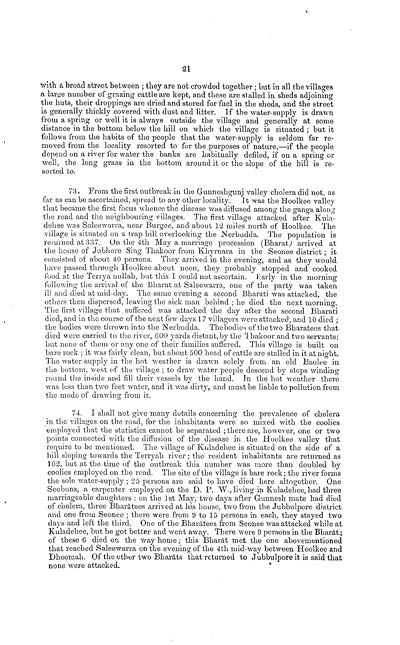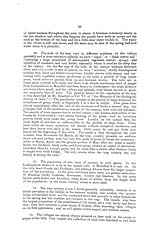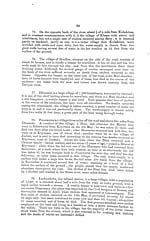Medicine - Disease > Report on the cholera epidemic of 1868
(42) Page 21
Download files
Individual page:
Thumbnail gallery: Grid view | List view

21
with a broad street between ; they are not crowded together ; but in all the villages
a large number of grazing cattle are kept, and these are stalled in sheds adjoining
the huts, their droppings are dried and stored for fuel in the sheds, and the street
is generally thickly covered with dust and litter. If the water-supply is drawn
from a spring or well it is always outside the village and generally at some
distance in the bottom below the hill on which the village is situated ; but it
follows from the habits of the people that the water-supply is seldom far re-
moved from the locality resorted to for the purposes of nature,-if the people
depend on a river for water the banks are habitually defiled, if on a spring or
well, the long grass in the bottom around it or the slope of the hill is re-
sorted to.
73. From the first outbreak in the Gunneshgunj valley cholera did not, as
far as can be ascertained, spread to any other locality. It was the Hoolkee valley
that became the first focus whence the disease was diffused among the gangs along
the road and the neighbouring villages. The first village attacked after Kula-
dehee was Saleewarra, near Burgee, and about 12 miles north of Hoolkee. The
village is situated on a trap hill overlooking the Nerbudda. The population is
returned at 337. On the 4th May a marriage procession (Bharat) arrived at
the house of Jubhore Sing Thakoor from "Khyrnara in the Seonee district ; it
consisted of about 40 persons. They arrived in the evening, and as they would
have passed through Hoolkee about noon, they probably stopped and cooked
food at the Terrya nullah, but this 1 could not ascertain. Early in the morning
following the arrival of the Bharat at Saleewarra, one of the party was taken
ill and died at mid-day. The same evening a second Bharati was attacked, the
others then dispersed, leaving the sick man behind : he died the next morning.
The first village that suffered was attacked the day after the second Bharati
died, and in the course of the next few days 17 villagers were attacked, and 10 died ;
the bodies were thrown into the Nerbudda. The bodies of the two Bharatees that
died were carried to the river, 600 yards distant, by the Thakoor and two servants;
but none of them or any one of their families suffered. This village is built on
bare rock ; it was fairly clean, but about 500 head of cattle are stalled in it at night.
The water-supply in the hot weather is drawn solely from an old Baolee in
the bottom, west of the village ; to draw water people descend by steps winding
round the inside and fill their vessels by the hand. In the hot weather there
was less than two feet water, and it was dirty, and must be liable to pollution from
the mode of drawing from it.
74. I shall not give many details concerning the prevalence of cholera
in the villages on the road, for the inhabitants were so mixed with the coolies
employed that the statistics cannot be separated ; there are, however, one or two
points connected with the diffusion of the disease in the Hoolkee valley that
require to be mentioned. The village of Kuladehee is situated on the side of a
hill sloping towards the Terry ah river ; the resident inhabitants are returned as
102, but at the time of the outbreak this number was more than doubled by
coolies employed on the road. The site of the village is bare rock; the river forms
the sole water-supply ; 25 persons are said to have died here altogether. One
Seobuns, a carpenter employed on the D. P. W., living in Kuladehee, had three
marriageable daughters : on the 1st May, two days after Gunnesh mate had died
of cholera, three Bharatees arrived at his house, two from the Jubbulpore district
and one from Seonee ; there were from 9 to 15 persons in each, they stayed two
days and left the third. One of the Bharatees from Seonee was attacked while at
Kuladehee, but he got better and went away. There were 9 persons in the Bharat;
of these 6 died on the way home ; this Bharat met the one abovementioned
that reached Saleewarra on the evening of the 4th mid-way between Hoolkee and
Dhoomah. Of the other two Bharats that returned to Jubbulpore it is said that
none were attacked.
with a broad street between ; they are not crowded together ; but in all the villages
a large number of grazing cattle are kept, and these are stalled in sheds adjoining
the huts, their droppings are dried and stored for fuel in the sheds, and the street
is generally thickly covered with dust and litter. If the water-supply is drawn
from a spring or well it is always outside the village and generally at some
distance in the bottom below the hill on which the village is situated ; but it
follows from the habits of the people that the water-supply is seldom far re-
moved from the locality resorted to for the purposes of nature,-if the people
depend on a river for water the banks are habitually defiled, if on a spring or
well, the long grass in the bottom around it or the slope of the hill is re-
sorted to.
73. From the first outbreak in the Gunneshgunj valley cholera did not, as
far as can be ascertained, spread to any other locality. It was the Hoolkee valley
that became the first focus whence the disease was diffused among the gangs along
the road and the neighbouring villages. The first village attacked after Kula-
dehee was Saleewarra, near Burgee, and about 12 miles north of Hoolkee. The
village is situated on a trap hill overlooking the Nerbudda. The population is
returned at 337. On the 4th May a marriage procession (Bharat) arrived at
the house of Jubhore Sing Thakoor from "Khyrnara in the Seonee district ; it
consisted of about 40 persons. They arrived in the evening, and as they would
have passed through Hoolkee about noon, they probably stopped and cooked
food at the Terrya nullah, but this 1 could not ascertain. Early in the morning
following the arrival of the Bharat at Saleewarra, one of the party was taken
ill and died at mid-day. The same evening a second Bharati was attacked, the
others then dispersed, leaving the sick man behind : he died the next morning.
The first village that suffered was attacked the day after the second Bharati
died, and in the course of the next few days 17 villagers were attacked, and 10 died ;
the bodies were thrown into the Nerbudda. The bodies of the two Bharatees that
died were carried to the river, 600 yards distant, by the Thakoor and two servants;
but none of them or any one of their families suffered. This village is built on
bare rock ; it was fairly clean, but about 500 head of cattle are stalled in it at night.
The water-supply in the hot weather is drawn solely from an old Baolee in
the bottom, west of the village ; to draw water people descend by steps winding
round the inside and fill their vessels by the hand. In the hot weather there
was less than two feet water, and it was dirty, and must be liable to pollution from
the mode of drawing from it.
74. I shall not give many details concerning the prevalence of cholera
in the villages on the road, for the inhabitants were so mixed with the coolies
employed that the statistics cannot be separated ; there are, however, one or two
points connected with the diffusion of the disease in the Hoolkee valley that
require to be mentioned. The village of Kuladehee is situated on the side of a
hill sloping towards the Terry ah river ; the resident inhabitants are returned as
102, but at the time of the outbreak this number was more than doubled by
coolies employed on the road. The site of the village is bare rock; the river forms
the sole water-supply ; 25 persons are said to have died here altogether. One
Seobuns, a carpenter employed on the D. P. W., living in Kuladehee, had three
marriageable daughters : on the 1st May, two days after Gunnesh mate had died
of cholera, three Bharatees arrived at his house, two from the Jubbulpore district
and one from Seonee ; there were from 9 to 15 persons in each, they stayed two
days and left the third. One of the Bharatees from Seonee was attacked while at
Kuladehee, but he got better and went away. There were 9 persons in the Bharat;
of these 6 died on the way home ; this Bharat met the one abovementioned
that reached Saleewarra on the evening of the 4th mid-way between Hoolkee and
Dhoomah. Of the other two Bharats that returned to Jubbulpore it is said that
none were attacked.
Set display mode to: Large image | Zoom image | Transcription
Images and transcriptions on this page, including medium image downloads, may be used under the Creative Commons Attribution 4.0 International Licence unless otherwise stated. ![]()
| India Papers > Medicine - Disease > Report on the cholera epidemic of 1868 > (42) Page 21 |
|---|
| Permanent URL | https://digital.nls.uk/74580644 |
|---|




